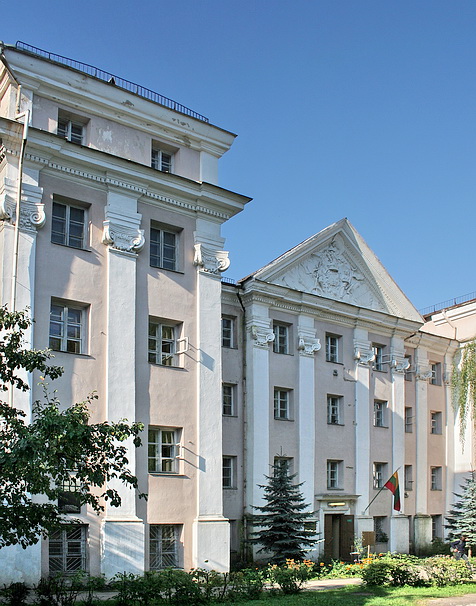Slushko Palace on:
[Wikipedia]
[Google]
[Amazon]

 Slushko Palace ( lt, Sluškų rūmai, pl, Pałac Słuszków) in Vilnius,
Slushko Palace ( lt, Sluškų rūmai, pl, Pałac Słuszków) in Vilnius,

 Slushko Palace ( lt, Sluškų rūmai, pl, Pałac Słuszków) in Vilnius,
Slushko Palace ( lt, Sluškų rūmai, pl, Pałac Słuszków) in Vilnius, Lithuania
Lithuania (; lt, Lietuva ), officially the Republic of Lithuania ( lt, Lietuvos Respublika, links=no ), is a country in the Baltic region of Europe. It is one of three Baltic states and lies on the eastern shore of the Baltic Sea. Lithuania ...
is a Baroque
The Baroque (, ; ) is a style of architecture, music, dance, painting, sculpture, poetry, and other arts that flourished in Europe from the early 17th century until the 1750s. In the territories of the Spanish and Portuguese empires including t ...
palace situated on the left bank of Neris River in the Old Town
In a city or town, the old town is its historic or original core. Although the city is usually larger in its present form, many cities have redesignated this part of the city to commemorate its origins after thorough renovations. There are ma ...
elderate, former Antakalnis suburb of the city.
The palace was erected in 1690–1700 by voivode of Polock
Połock Voivodeship ( pl, Województwo połockie, be, Полацкае ваяводства) was a unit of administrative division and local government in the Polish–Lithuanian Commonwealth ( Grand Duchy of Lithuania) since the 15th century ...
Dominik Słuszko of the Clan of Ostoja
The Clan of Ostoja (old Polish: ''Ostoya'') was a powerful group of knights and lords in late-medieval Europe. The clan encompassed families in the Polish–Lithuanian Commonwealth (including present-day Belarus and Ukraine), Hungary and Upper Hu ...
, who ordered creating an artificial peninsula
A peninsula (; ) is a landform that extends from a mainland and is surrounded by water on most, but not all of its borders. A peninsula is also sometimes defined as a piece of land bordered by water on three of its sides. Peninsulas exist on all ...
on Neris for the purpose of building the palace there. The peninsula was formed from the soil of the leveled down hill separating Antakalnis from the Vilnius Castle
The Vilnius Castle Complex ( lt, Vilniaus pilių kompleksas or ) is a group of cultural, and historic structures on the left bank of the Neris River, near its confluence with the Vilnia River, in Vilnius, Lithuania. The buildings, which evolved b ...
s. Initially the façades of the palace were unified by a giant order of Ionic pilasters framing huge windows. It is believed that the decoration works of the palace were performed by Michelangelo Palloni and Giovanni Pietro Perti
Giovanni Pietro Perti or Peretti (1648 – 1714) was an Italian Baroque sculptor and architect, regarded as one of the leading European sculptors on the verge of the 18th century. He has been an elder of Šnipiškės and Antakalnis suburbs gove ...
who was the architect of the palace.
The Polish–Lithuanian rulers used to stay in the palace during their visits in the city after the Royal Palace
This is a list of royal palaces, sorted by continent.
Africa
* Abdin Palace, Cairo
* Al-Gawhara Palace, Cairo
* Koubbeh Palace, Cairo
* Tahra Palace, Cairo
* Menelik Palace
* Jubilee Palace
* Guenete Leul Palace
* Imperial Palace- Massa ...
was damaged. The Russian tsar
Tsar ( or ), also spelled ''czar'', ''tzar'', or ''csar'', is a title used by East Slavs, East and South Slavs, South Slavic monarchs. The term is derived from the Latin word ''Caesar (title), caesar'', which was intended to mean "emperor" i ...
Peter the Great
Peter I ( – ), most commonly known as Peter the Great,) or Pyotr Alekséyevich ( rus, Пётр Алексе́евич, p=ˈpʲɵtr ɐlʲɪˈksʲejɪvʲɪtɕ, , group=pron was a Russian monarch who ruled the Tsardom of Russia from t ...
stayed and had his headquarters
Headquarters (commonly referred to as HQ) denotes the location where most, if not all, of the important functions of an organization are coordinated. In the United States, the corporate headquarters represents the entity at the center or the to ...
established here in 1705 and 1709.
After Słuszko's death the palace was owned by the Puzyna princely family (of Rurikid
The Rurik dynasty ( be, Ру́рыкавічы, Rúrykavichy; russian: Рю́риковичи, Ryúrikovichi, ; uk, Рю́риковичі, Riúrykovychi, ; literally "sons/scions of Rurik"), also known as the Rurikid dynasty or Rurikids, was ...
stock) since 1727 and by the Potocki
The House of Potocki (; plural: Potoccy, male: Potocki, feminine: Potocka) was a prominent Polish noble family in the Kingdom of Poland and magnates of the Polish–Lithuanian Commonwealth. The Potocki family is one of the wealthiest and ...
family since 1745. The Piarist monks bought the palace in 1756 and established a collegiate and a printing house. Later it was bought by Michał Kazimierz Ogiński in 1766 and reconstructed by Pietro Rossi. The palace was confiscated by the tsarist government in 1794 and transformed into an apartment house. It housed a brewery of Dominik Zajkowski from 1803 until 1831 when the palace was taken by tsarist military. The building was rearranged, the floors were redivided into four, and the palace served as a military prison since 1872. The rich original interior and exterior of the palace have not survived.
Nowadays the palace houses the Lithuanian Academy of Music and Theatre
The Lithuanian Academy of Music and Theatre in Vilnius, Lithuania, is a state-supported conservatory that trains students in music, theatre, and multimedia arts.
History
Composer Juozas Naujalis founded a music school in 1919 in Kaunas. This ...
. In the meantime the outhouses are undergoing the restoration and the main palace is planned to come next. The palace is planned to regain its original two main floors layout and original Baroque style windows.
References
{{Authority control Palaces in Vilnius Houses completed in 1700 Baroque palaces in Lithuania 1700 establishments in Europe